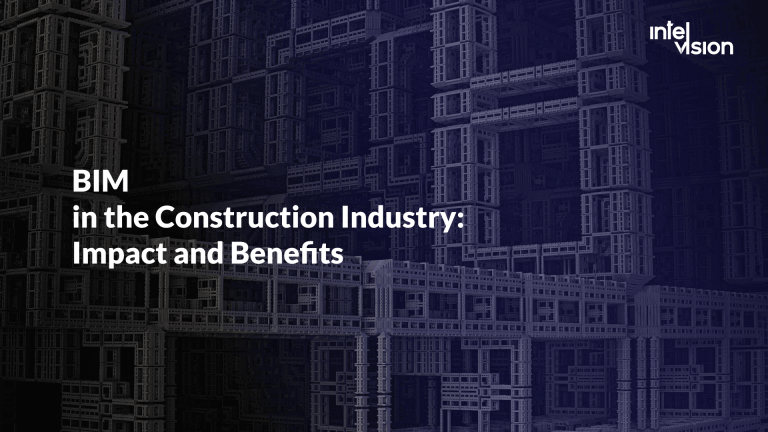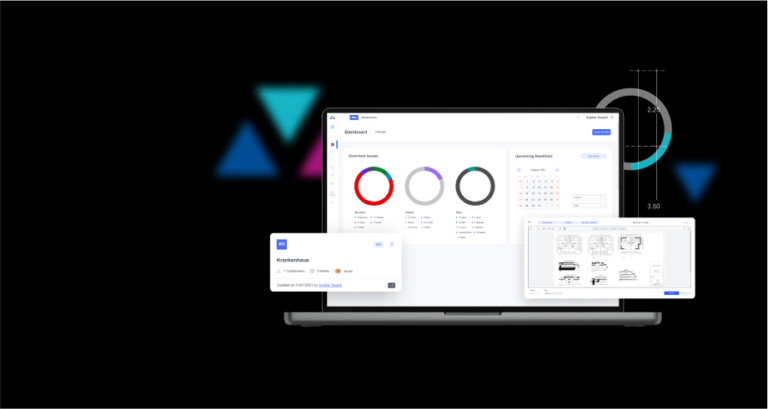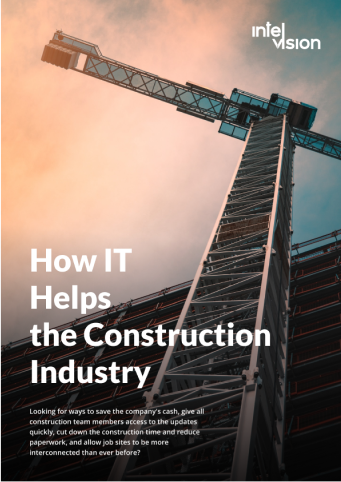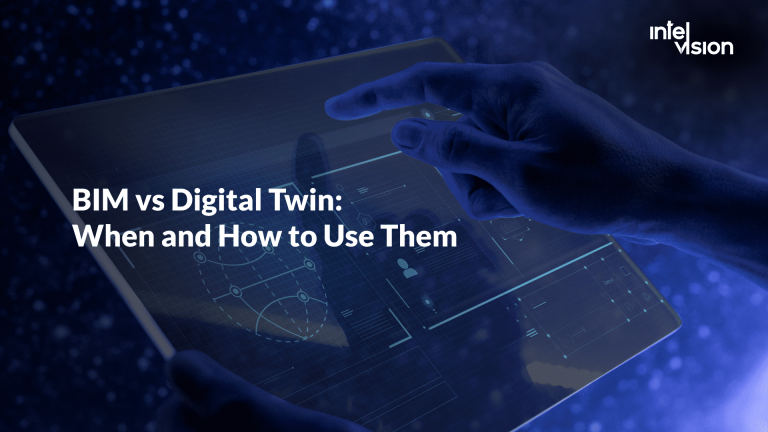
BIM vs Digital Twin: When and How to Use Them
In the growing era of smart buildings, developers, builders, engineers, and construction teams in general need the foresight that comes with dynamic building plans. Then, after it’s constructed, facility managers need a way to oversee space in practice which boils down to a discussion about BIM and digital twins. What are digital twin and BIM? Both are important, and both are distinct. Let’s take a look at what makes BIM software development and digital twins unique.
What is Building Information Modeling (BIM)?
Building Information Modeling (BIM) is a digital representation and collaborative process that enables the efficient planning, design, construction, and operation of buildings and infrastructure.
At its core, BIM is a 3D model-based approach that incorporates both geometric and non-geometric information about a building or infrastructure project. It goes beyond traditional computer-aided design (CAD) by integrating data and information from multiple sources into a single, comprehensive model. This digital model becomes a shared knowledge resource for all project participants, providing valuable insights and facilitating better decision-making throughout the entire project lifecycle.
For example, engineers can simulate the behavior of structural components, analyze energy performance, or test different design alternatives for optimal results. Contractors can estimate quantities and costs, plan construction sequences, and identify potential clashes before they occur on-site.
What is Digital Twin Technology?
Digital twin technology involves creating a virtual replica or representation of a physical object, process, or system. It is built using various technologies such as sensors, Internet of Things (IoT) devices, data analytics, and artificial intelligence (AI). These technologies collect real-time data from the physical object or system and feed it into the digital twin, creating a synchronized and up-to-date representation.
Furthermore, digital twins support the concept of a “system of systems.” In complex environments where multiple interconnected systems or processes are at play, digital twins provide a holistic view and enable better coordination. For instance, in a smart city, digital twins can represent various infrastructure components like transportation networks, utilities, and public spaces. By integrating data from different sources, city planners can gain insights into overall performance, identify bottlenecks, and make data-driven decisions to improve efficiency and livability.
Looking ahead, the future of digital twin technology is promising. As AI and machine learning capabilities advance, digital twin technology will become more intelligent, capable of autonomous decision-making, and adaptive behavior. They will integrate with other emerging technologies such as augmented reality (AR) and virtual reality (VR), enabling immersive visualization and enhanced user experiences.
Difference Between Digital Twins and BIM
What is the fundamental difference between BIM and digital twin? While both BIM and digital twins are advanced technologies used in the construction and engineering sectors, they have distinct differences in terms of their scope, purpose, and functionality.
Digital Twin:
- Scope: Digital twins encompass a broader range of applications beyond the construction and AEC industry. They can represent physical objects, systems, processes, and even entire cities or ecosystems. Digital twins are dynamic, real-time representations that capture data and behavior from the physical counterparts they model.
- Real-time Monitoring and Analysis: Digital twins are designed to continuously collect data from sensors and IoT devices embedded in the physical objects or systems they represent. This real-time data feeds into the digital twin, allowing for monitoring, analysis, and simulation. Digital twins enable predictive maintenance, optimization, and remote control of physical assets.
- Virtual-Physical Synchronization: Digital twins are closely synchronized with their physical counterparts, mirroring their behavior and characteristics in real time. They provide a digital representation that evolves and updates alongside changes in the physical world.
- Adaptive and Autonomous: Digital twins can use artificial intelligence (AI) and machine learning algorithms to learn from the collected data and make autonomous decisions. They can adapt to changes, and simulate various scenarios to improve operations and outcomes.
Building Information Modeling (BIM):
- Scope: BIM software primarily focuses on building’s design, construction, and operation of building projects. It provides a collaborative and data-driven approach to project delivery, enabling stakeholders to create and manage 3D models that contain detailed information about the project’s components.
- Information Integration: Building Information Modeling integrates various data and information sources into a centralized model, including geometric data, material specifications, cost data, and more. It facilitates collaboration and coordination among different disciplines involved in the construction process, reducing conflicts and improving efficiency.
- Lifecycle Management: BIM process supports the entire project lifecycle, from design and construction to operation and maintenance. It allows for better decision-making during the design phase, quantity estimation, clash detection and scheduling during the construction phase, and information handover for facility management and maintenance.
- Visualization and Analysis: Building Information Modeling provides visual representations of the building or infrastructure project, enabling stakeholders to visualize and analyze different aspects. It allows for energy analysis, structural simulations, clash detection, and virtual construction planning. BIM software helps stakeholders make informed decisions and optimize project outcomes.
In summary, digital twins have a broader scope, representing various objects, systems, and processes beyond the construction and AEC industry. They focus on real-time monitoring, analysis, and autonomous behavior. On the other hand, BIM primarily focuses on infrastructure and building projects, facilitating collaboration, information integration, and lifecycle management. Building Information Modeling emphasizes visualization, analysis, and decision-making support throughout the project lifecycle.
Top 4 Benefits of Digital Twin and BIM Integration
By combining the real-time monitoring and analysis capabilities of digital twins with the collaborative and information-rich environment of BIM, stakeholders can unlock new levels of efficiency, optimization, and decision-making throughout the entire lifecycle of a project. We’ve highlighted the key benefits of integrating digital twin and BIM.
Enhanced Visualization and Simulation
The integration allows for a seamless transfer of data and information between the digital twin and BIM model. It enables stakeholders to visualize and simulate the behavior of the physical asset represented by the digital twin within the BIM environment. Moreover, it provides a comprehensive understanding of the asset’s performance, interactions, and potential issues, leading to better design decisions, optimized construction processes, and improved operation and maintenance strategies.
Proactive Maintenance and Facility Management
Real-time data from the digital twin can be leveraged within the BIM model to predict maintenance needs, identify potential failures, and optimize maintenance schedules. Facility managers can access accurate and up-to-date information about physical assets, such as equipment specifications, maintenance history, and performance data, allowing for timely interventions and cost-effective maintenance strategies.
Data-Driven Decision Making
Construction software development and BIM/digital twin technology enables data-driven decision-making throughout the project lifecycle. Real-time data from the digital twin can be combined with the information-rich BIM model, allowing stakeholders to analyze trends, identify patterns, and make informed decisions.
Improved Collaboration and Communication
Integrating Digital Twin and building information models enhances collaboration and communication among project stakeholders. The integration allows for seamless sharing of data, information, and insights, fostering a collaborative environment where stakeholders can work together more efficiently.
How to Use Digital Twins and BIM in Construction
The integration of BIM vs Digital Twin in the AEC industry offers numerous benefits and opportunities for enhanced project planning, design, construction, and facility management. Here are the key steps to effectively use digital twins and BIM in construction:
Project Planning and Design Phase
- Establish Project Objectives: Clearly define the project objectives, including key performance indicators, sustainability goals, and client requirements. Determine how digital twins and BIM can support these objectives.
- Data Collection and Digital Models Creation: Gather relevant data, including architectural, structural, mechanical, electrical, and plumbing drawings, specifications, and site survey information. Develop a comprehensive digital model that represents the project’s physical and functional characteristics.
- Integration of Digital Twin and BIM: Establish the connection between the digital twin and BIM model. Define the data exchange protocols and the parameters to be monitored in real time by the digital twin.
- Clash Detection and Simulation: Utilize the BIM model to identify clashes, conflicts, and constructability issues. Simulate different design scenarios to optimize performance, resource allocation, and energy efficiency.
Construction Phase
- Real-time Monitoring: Deploy sensors and IoT devices to collect real-time data from the construction site and feed it into the digital twin. Monitor parameters such as progress, equipment utilization, environmental conditions, and safety metrics.
- Collaboration and Coordination: Foster collaboration among various project stakeholders, including architects, engineers, contractors, and subcontractors. Use the BIM model as a central platform for sharing information, communicating changes, and resolving conflicts.
- Virtual Construction Planning: Utilize the BIM model and digital twin to simulate construction processes, optimize resource allocation, and evaluate construction sequencing. Visualize the construction progress and identify potential bottlenecks or inefficiencies.
Facility Management and Operation Phase
- As-Built Documentation: Update the BIM model with as-built information, including changes made during construction, equipment specifications, and maintenance history. Ensure accurate and up-to-date as-built documentation for future reference.
- Asset Monitoring and Maintenance: Monitor asset performance using the digital twin. Analyze data to identify possible issues, predict maintenance needs, and optimize asset utilization. Implement proactive maintenance strategies to reduce downtime and extend asset lifespan.
- Data-driven Decision Making: Utilize the wealth of data from the digital twin and BIM model to make informed decisions about asset management, maintenance planning, energy optimization, and facility improvements. Implement data analytics and visualization tools to gain insights and drive continuous improvement.
The integration of these technologies can revolutionize the construction industry by enabling data-driven decision-making, proactive maintenance, and efficient facility management in construction.
Smarter Building Requires Smarter Tech
The rise of Digital Twin vs BIM in construction is not a coincidence—it’s a necessity. Nowadays, smart buildings are more complex than they have ever been. Conversely, we also expect more from our spaces than we ever have before. BIM and digital twins together make it easier to manage these complex spaces and all the expectations companies have for them. They have enabled smart buildings to become dynamic, from conception to utilization.
Start your digital transformation in order to seize the opportunities and help mitigate the risks. We help companies thrive in the transformative age by refreshing themselves constantly, experimenting with new software solutions and scaling successes.









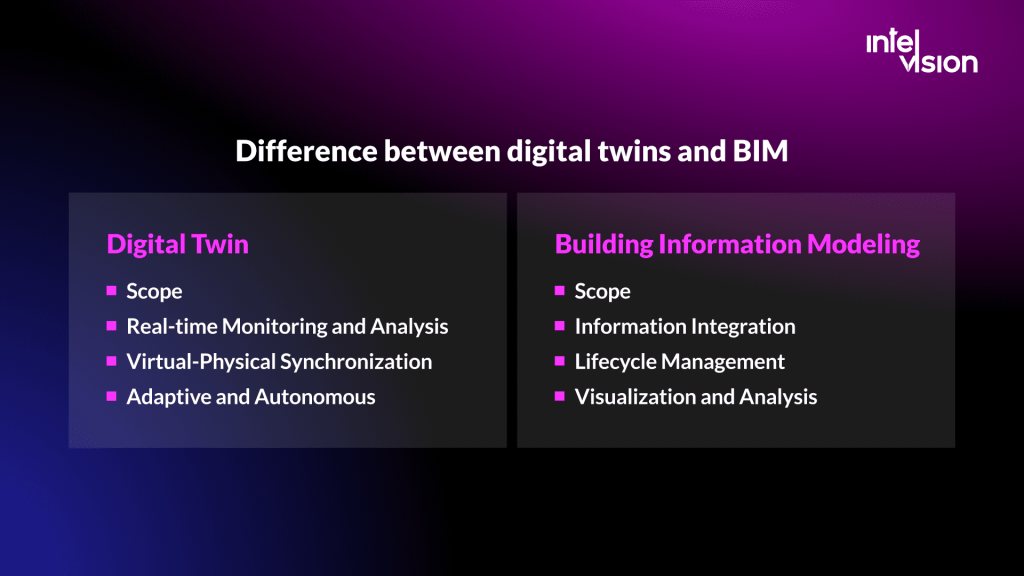
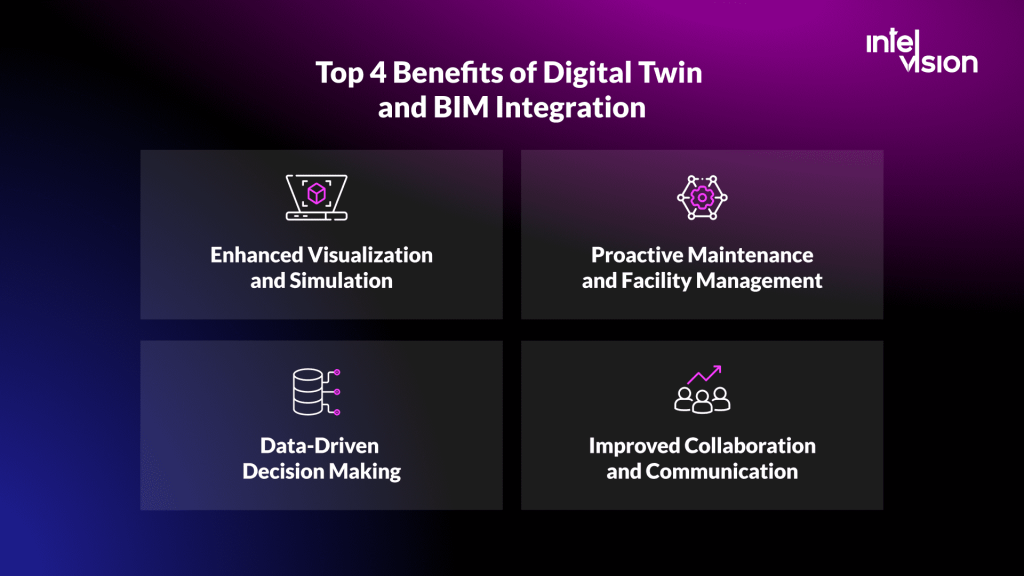
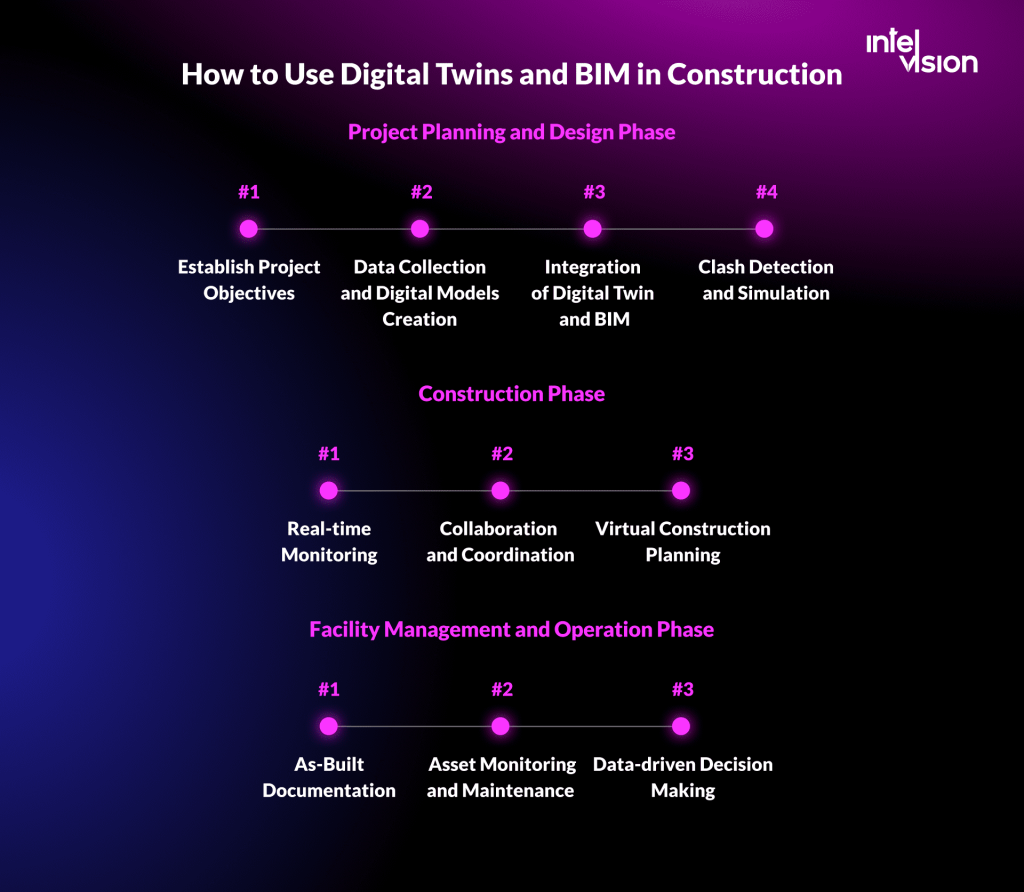
![$portfolio_img_mobile['title'] $portfolio_img_mobile['alt']](https://intelvision.pro/wp-content/uploads/2022/11/Visoplan.-Mobile-banner-263x350.png)

